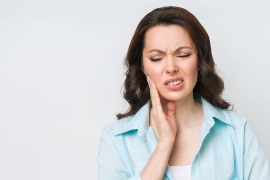 Have you ever woken up from a deep sleep and rubbed the area right in front of your ear because it’s sore? If so, you’ve experienced at least a mild version of TMJ dysfunction. The TMJ can be a very painful area and create a hassle over time. If left untreated, it affects your sleeping, eating and posture. Here, we’ll discuss TMJ dysfunction and what you can do about it.
Have you ever woken up from a deep sleep and rubbed the area right in front of your ear because it’s sore? If so, you’ve experienced at least a mild version of TMJ dysfunction. The TMJ can be a very painful area and create a hassle over time. If left untreated, it affects your sleeping, eating and posture. Here, we’ll discuss TMJ dysfunction and what you can do about it.
The TMJ, or temporomandibular joint, is where the jawbone meets the skull on each side of the face. A convex condyle on both the right and left upper tips of the mandible (jawbone) articulate with a concave temporal bone on the skull. Between each bone lies a disc that helps absorb stresses on the joint. The movements created by this joint open and close the jaw and move the jaw side to side. Since we use these motions to do everything from yawning and swallowing to munching on our favorite snack, it’s easy to imagine how debilitating it would be to have a painful TMJ.
While there are supporting ligaments and muscles holding this ball-and-socket joint in a stable position, bad things can happen over time. The disc can get stuck, pinched, or even slip out of place. Grinding your teeth at night can cause the joint capsule to wear out and become painful. The muscles that help the joint open and close can go into a spasm, pulling the jaw to one side. There’s a lot that can go wrong, but why do these things happen? As with many other modern-day ailments, we don’t have to look much further than our posture.
The past two years of dealing with COVID-19 have proven to be challenging in countless ways. Wearing masks has been a vital part of keeping ourselves and our loved ones safe. But it has had its consequences, although indirectly. Studies show that mask-wearing by itself does not cause any TMJ dysfunction, however, poor posture and neck pain are both highly correlated with TMJ dysfunction and wearing a mask can worsen poor posture.
Posture is the strategy used by the neuromuscular and skeletal systems to remain in balance and react to the force of gravity.
Imaging studies have shown that the jaw system actively participates in maintaining the correct position of the skull as we hold our heads up. Thus, if you have TMJ pain, poor posture may be at the root of it. Take a mental snapshot of yourself while sending a text. Are your shoulders rounded, head bent forward, and back hunched? Now, imagine doing the same thing wearing a mask. You’d have to bend your head down even further to see over your mask, which is horrible for your posture.
Posture may be one contributing factor to TMJ dysfunction, and wearing a mask can make it even worse. If you’re experiencing jaw pain, talk to your physical therapist today!
References
1. Alomar X, Medrano J, Cabratosa J, et al. Anatomy of the temporomandibular joint. Semin Ultrasound CT MR. 2007;28(3):170-183. doi:10.1053/j.sult.2007.02.002
2. Fiorillo L, Musumeci G. TMJ Dysfunction and Systemic Correlation. J Funct Morphol Kinesiol. 2020;5(1):20. Published 2020 Mar 9. doi:10.3390/jfmk5010020
3. Walczyńska-Dragon K, Baron S, Nitecka-Buchta A, Tkacz E. Correlation between TMD and cervical spine pain and mobility: is the whole body balance TMJ related?. Biomed Res Int. 2014;2014:582414. doi:10.1155/2014/582414
4. Butts R, Dunning J, Pavkovich R, Mettille J, Mourad F. Conservative management of temporomandibular dysfunction: A literature review with implications for clinical practice guidelines (Narrative review part 2). J Bodyw Mov Ther. 2017;21(3):541-548. doi:10.1016/j.jbmt.2017.05.021
Be Inspired




